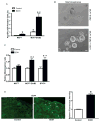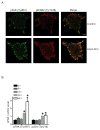Cellular and molecular mechanisms underlying alcohol-induced aggressiveness of breast cancer
- PMID: 27939360
- PMCID: PMC5205572
- DOI: 10.1016/j.phrs.2016.12.005
Cellular and molecular mechanisms underlying alcohol-induced aggressiveness of breast cancer
Abstract
Breast cancer is a leading cause of morbidity and mortality in women. Both Epidemiological and experimental studies indicate a positive correlation between alcohol consumption and the risk of breast cancer. While alcohol exposure may promote the carcinogenesis or onset of breast cancer, it may as well enhance the progression and aggressiveness of existing mammary tumors. Recent progress in this line of research suggests that alcohol exposure is associated with invasive breast cancer and promotes the growth and metastasis of mammary tumors. There are multiple potential mechanisms involved in alcohol-stimulated progression and aggressiveness of breast cancer. Alcohol may increase the mobility of cancer cells by inducing cytoskeleton reorganization and enhancing the cancer cell invasion by causing degradation and reconstruction of the extracellular matrix (ECM). Moreover, alcohol may promote the epithelial-mesenchymal transition (EMT), a hallmark of malignancy, and impair endothelial integrity, thereby increasing the dissemination of breast cancer cells and facilitating metastasis. Furthermore, alcohol may stimulate tumor angiogenesis through the activation of cytokines and chemokines which promotes tumor growth. Additionally, alcohol may increase the cancer stem cell population which affects neoplastic cell behavior, aggressiveness, and the therapeutic response. Alcohol can be metabolized in the mammary tissues and breast cancer cells which produces reactive oxygen species (ROS), causing oxidative stress. Recent studies suggest that the epidermal growth factor receptor (EGFR) family, particularly ErbB2 (a member of this family), is involved in alcohol-mediated tumor promotion. Breast cancer cells or mammary epithelial cells over-expressing ErbB2 are more sensitive to alcohol's tumor promoting effects. There is considerable cross-talk between oxidative stress and EGFR/ErbB2 signaling. This review further discusses how the interaction between oxidative stress and EGFR/ErbB2 signaling contributes to the cellular and molecular events associated with breast cancer aggressiveness. We also discuss the potential therapeutic approaches for cancer patients who drink alcoholic beverages.
Keywords: Alcoholism; Cancer stem cells; Carcinogenesis; Estrogen; HER2/ErbB2; Oxidative stress.
Copyright © 2016 Elsevier Ltd. All rights reserved.
Conflict of interest statement
The authors declare that there are no conflicts of interest.
Figures



Similar articles
-
Overexpression of ErbB2 enhances ethanol-stimulated intracellular signaling and invasion of human mammary epithelial and breast cancer cells in vitro.Oncogene. 2003 Aug 14;22(34):5281-90. doi: 10.1038/sj.onc.1206675. Oncogene. 2003. PMID: 12917629
-
ErbB2 and p38γ MAPK mediate alcohol-induced increase in breast cancer stem cells and metastasis.Mol Cancer. 2016 Jul 14;15(1):52. doi: 10.1186/s12943-016-0532-4. Mol Cancer. 2016. PMID: 27416801 Free PMC article.
-
FUT8 promotes breast cancer cell invasiveness by remodeling TGF-β receptor core fucosylation.Breast Cancer Res. 2017 Oct 5;19(1):111. doi: 10.1186/s13058-017-0904-8. Breast Cancer Res. 2017. PMID: 28982386 Free PMC article.
-
Epithelial Mesenchymal Transition in Aggressive Lung Cancers.Adv Exp Med Biol. 2016;890:37-56. doi: 10.1007/978-3-319-24932-2_3. Adv Exp Med Biol. 2016. PMID: 26703798 Review.
-
Tumor and its microenvironment: a synergistic interplay.Semin Cancer Biol. 2013 Dec;23(6 Pt B):522-32. doi: 10.1016/j.semcancer.2013.08.007. Epub 2013 Sep 4. Semin Cancer Biol. 2013. PMID: 24012661 Review.
Cited by
-
The effect of modifiable risk factors on breast cancer aggressiveness among black and white women.Am J Surg. 2019 Oct;218(4):689-694. doi: 10.1016/j.amjsurg.2019.07.012. Epub 2019 Jul 18. Am J Surg. 2019. PMID: 31375248 Free PMC article.
-
PM2.5, Fine Particulate Matter: A Novel Player in the Epithelial-Mesenchymal Transition?Front Physiol. 2019 Nov 29;10:1404. doi: 10.3389/fphys.2019.01404. eCollection 2019. Front Physiol. 2019. PMID: 31849690 Free PMC article. Review.
-
Breast Cancer Exposomics.Life (Basel). 2024 Mar 18;14(3):402. doi: 10.3390/life14030402. Life (Basel). 2024. PMID: 38541726 Free PMC article. Review.
-
Integrative Analysis of DNA Methylation and microRNA Reveals GNPDA1 and SLC25A16 Related to Biopsychosocial Factors Among Taiwanese Women with a Family History of Breast Cancer.J Pers Med. 2025 Mar 30;15(4):134. doi: 10.3390/jpm15040134. J Pers Med. 2025. PMID: 40278313 Free PMC article.
-
Alcohol promotes epithelial mesenchymal transformation-mediated premetastatic niche formation of colorectal cancer by activating interaction between laminin-γ2 and integrin-β1.World J Gastroenterol. 2022 Sep 21;28(35):5154-5174. doi: 10.3748/wjg.v28.i35.5154. World J Gastroenterol. 2022. PMID: 36188720 Free PMC article.
References
-
- Becker S. A historic and scientific review of breast cancer: The next global healthcare challenge. Int J Gynaecol Obstet. 2015;131(Suppl 1):S36–9. - PubMed
-
- Oeffinger KC, Fontham ET, Etzioni R, Herzig A, Michaelson JS, Shih YC, Walter LC, Church TR, Flowers CR, LaMonte SJ, Wolf AM, DeSantis C, Lortet-Tieulent J, Andrews K, Manassaram-Baptiste D, Saslow D, Smith RA, Brawley OW, Wender R American Cancer S. Breast Cancer Screening for Women at Average Risk: 2015 Guideline Update From the American Cancer Society. Jama. 2015;314(15):1599–614. - PMC - PubMed
-
- Gerber B, Muller H, Reimer T, Krause A, Friese K. Nutrition and lifestyle factors on the risk of developing breast cancer. Breast cancer research and treatment. 2003;79(2):265–76. - PubMed
-
- Wogan GN, Hecht SS, Felton JS, Conney AH, Loeb LA. Environmental and chemical carcinogenesis. Semin Cancer Biol. 2004;14(6):473–86. - PubMed
Publication types
MeSH terms
Substances
Grants and funding
LinkOut - more resources
Full Text Sources
Other Literature Sources
Medical
Research Materials
Miscellaneous

